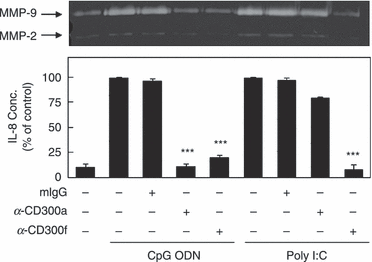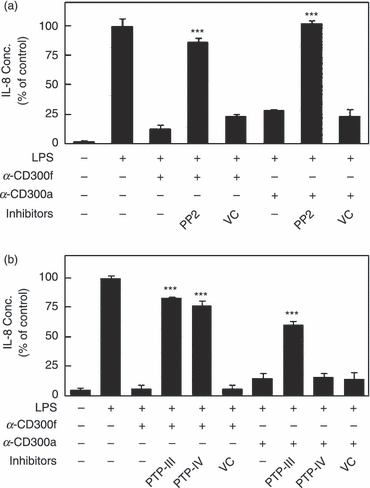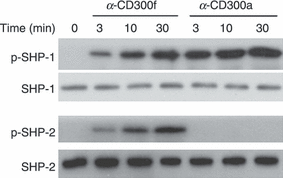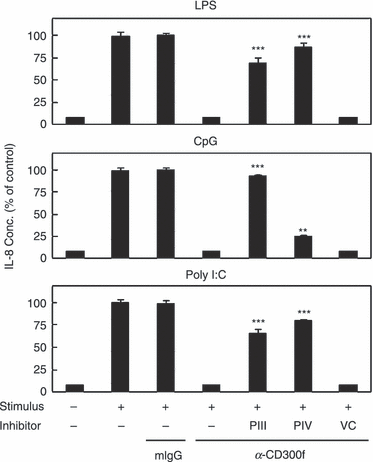CD300a and CD300f differentially regulate the MyD88 and TRIF-mediated TLR signalling pathways through activation of SHP-1 and/or SHP-2 in human monocytic cell lines
- PMID: 22043923
- PMCID: PMC3311045
- DOI: 10.1111/j.1365-2567.2011.03528.x
CD300a and CD300f differentially regulate the MyD88 and TRIF-mediated TLR signalling pathways through activation of SHP-1 and/or SHP-2 in human monocytic cell lines
Abstract
CD300a, a membrane protein expressed on myeloid lineages and specific subsets of CD4(+) T cells, has been reported to have inhibitory activities in cellular activation. However, the role of CD300a in Toll-like receptor (TLR) -mediated macrophage activation has not been investigated. The human monocytic cell lines THP-1 and U937 were stimulated with various TLR ligands after triggering of CD300a with specific monoclonal antibody. Interestingly, CD300a blocked TLR4-mediated and TLR9-mediated expression of pro-inflammatory mediators without affecting TLR3-mediated events. In contrast, CD300f, another member of the CD300 family, blocked the activation of cells induced by all TLR ligands. A transient transfection assay using luciferase reporter gene under the regulation of nuclear factor-κB binding sites indicated that co-transfection of CD300f blocked reporter expression induced by over-expression of both myeloid differentiation factor 88 (MyD88) and toll-interleukin 1 receptor-domain-containing adapter-inducing interferon-β (TRIF), whereas CD300a blocked only MyD88-induced events. Synthetic peptides representing immunoreceptor tyrosine-based inhibitory motifs of CD300a or CD300f mimicked the differential inhibition patterns of their original molecules. The use of various signalling inhibitors and Western blotting analysis revealed that TLR9/MyD88-mediated signalling was regulated mainly by SH2-containing tyrosine phosphatase 1 (SHP-1), which could be activated by CD300a or CD300f. In contrast, regulation of the TLR3/TRIF-mediated pathway required the combined action of SHP-1 and SHP-2, which could be accomplished by CD300f but not CD300a. These data indicate that CD300a and CD300f regulate the MyD88 and TRIF-mediated TLR signalling pathways through differential activation of SHP-1 and SHP-2.
© 2011 The Authors. Immunology © 2011 Blackwell Publishing Ltd.
Figures









Similar articles
-
CD300F blocks both MyD88 and TRIF-mediated TLR signaling through activation of Src homology region 2 domain-containing phosphatase 1.J Immunol. 2011 Jun 1;186(11):6296-303. doi: 10.4049/jimmunol.1002184. Epub 2011 May 2. J Immunol. 2011. PMID: 21536801
-
Synthetic peptides containing ITIM-like sequences of IREM-1 (CD300F) differentially regulate MyD88 and TRIF-mediated TLR signalling through activation of SHP and/or PI3K.Clin Exp Immunol. 2012 Mar;167(3):438-46. doi: 10.1111/j.1365-2249.2011.04528.x. Clin Exp Immunol. 2012. PMID: 22288587 Free PMC article.
-
SHPS-1 and a synthetic peptide representing its ITIM inhibit the MyD88, but not TRIF, pathway of TLR signaling through activation of SHP and PI3K in THP-1 cells.Inflamm Res. 2013 Apr;62(4):377-86. doi: 10.1007/s00011-013-0589-0. Epub 2013 Jan 12. Inflamm Res. 2013. PMID: 23314616
-
Modulation of Toll-interleukin 1 receptor mediated signaling.J Mol Med (Berl). 2005 Apr;83(4):258-66. doi: 10.1007/s00109-004-0622-4. Epub 2005 Jan 21. J Mol Med (Berl). 2005. PMID: 15662540 Review.
-
Microbial recognition by Toll-like receptors.J Dermatol Sci. 2004 Apr;34(2):73-82. doi: 10.1016/j.jdermsci.2003.10.002. J Dermatol Sci. 2004. PMID: 15033189 Review.
Cited by
-
CMRF35-like molecule 1 (CLM-1) regulates eosinophil homeostasis by suppressing cellular chemotaxis.Mucosal Immunol. 2014 Mar;7(2):292-303. doi: 10.1038/mi.2013.47. Epub 2013 Jul 3. Mucosal Immunol. 2014. PMID: 23820751
-
CD300a contributes to the resolution of articular inflammation triggered by MSU crystals by controlling neutrophil apoptosis.Immunology. 2021 Oct;164(2):305-317. doi: 10.1111/imm.13371. Epub 2021 Jun 6. Immunology. 2021. PMID: 34002852 Free PMC article.
-
Antithrombin: An anticoagulant, anti-inflammatory and antibacterial serpin.J Thromb Haemost. 2020 Mar;18(3):528-533. doi: 10.1111/jth.14724. J Thromb Haemost. 2020. PMID: 32112532 Free PMC article. No abstract available.
-
Dehydroandrographolide alleviates rheumatoid arthritis by inhibiting neutrophil activation via LMIR3 in collagen induced arthritis rats.Cell Cycle. 2024 Jan;23(1):1-14. doi: 10.1080/15384101.2024.2304508. Epub 2024 Jan 17. Cell Cycle. 2024. PMID: 38234233 Free PMC article.
-
Quercetin Attenuates MRGPRX2-Mediated Mast Cell Degranulation via the MyD88/IKK/NF-κB and PI3K/AKT/ Rac1/Cdc42 Pathway.J Inflamm Res. 2024 Oct 7;17:7099-7110. doi: 10.2147/JIR.S480644. eCollection 2024. J Inflamm Res. 2024. PMID: 39398230 Free PMC article.
References
-
- Cantoni C, Bottino C, Augugliaro R, et al. Molecular and functional characterization of IRp60, a member of the immunoglobulin superfamily that functions as an inhibitory receptor in human NK cells. Eur J Immunol. 1999;29:3148–59. - PubMed
-
- Green BJ, Clark GJ, Hart DN. The CMRF-35 mAb recognizes a second leukocyte membrane molecule with a domain similar to the poly Ig receptor. Int Immunol. 1998;10:891–9. - PubMed
-
- Clark GJ, Rao M, Ju X, Hart DN. Novel human CD4+ T lymphocyte subpopulations defined by CD300a/c molecule expression. J Leukoc Biol. 2007;82:1126–35. - PubMed
Publication types
MeSH terms
Substances
LinkOut - more resources
Full Text Sources
Molecular Biology Databases
Research Materials
Miscellaneous

